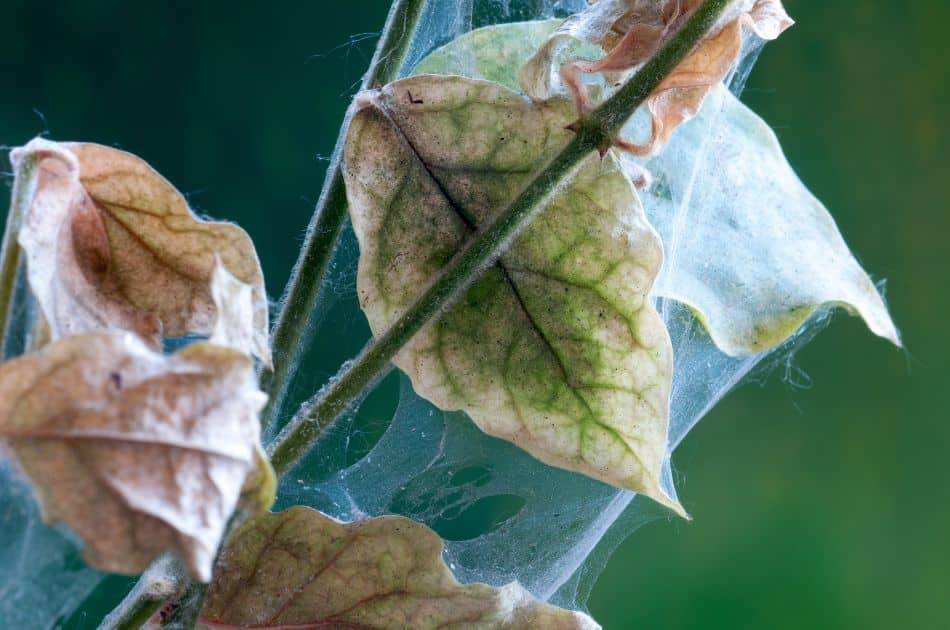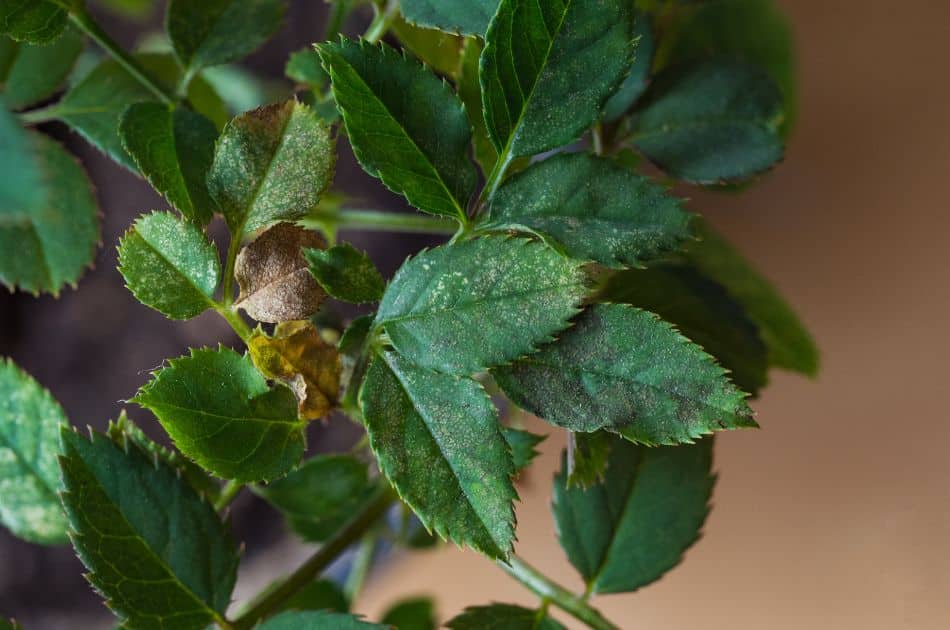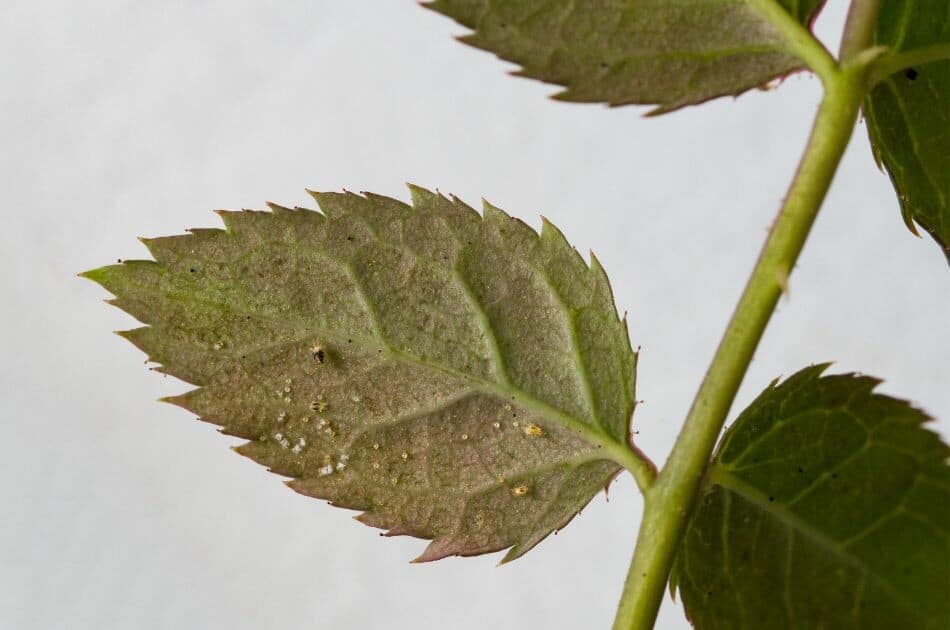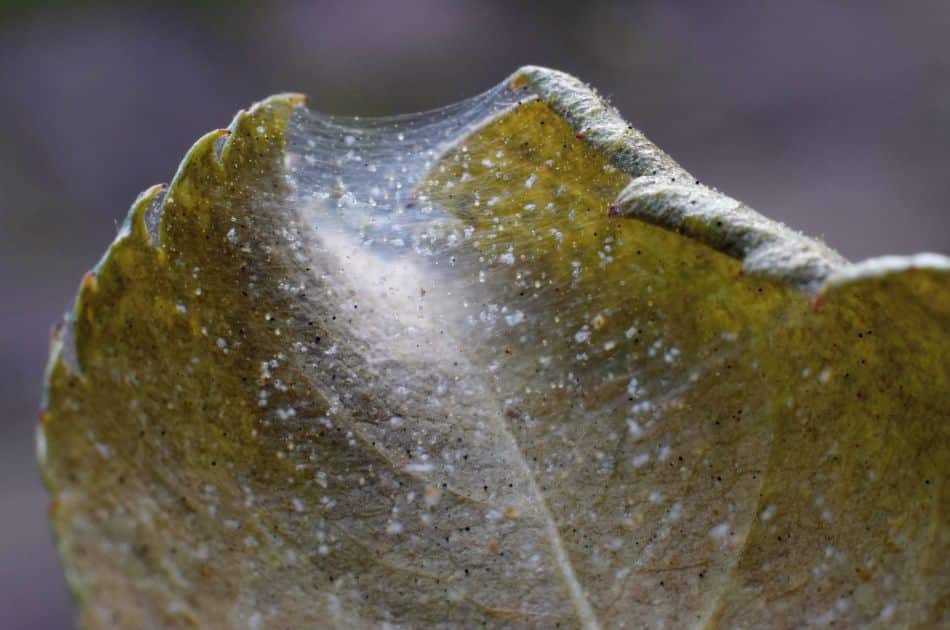What is a spider mite? It is a pest that is so tiny that it’s hard to spot, but one that can cause a lot of damage to your trees and plants. While one of these diminutive pests may not be an issue, there’s never just one.
In this article, we’ll go over:
- what spider mites are
- what plants they might impact
- how to check if your trees or plants have spider mites infestation
- how to prevent and treat spider mites
Keep reading to learn about these small but destructive pests.
Do Your Leaves Have Yellow or White Spots? You May Have Spider Mites
Spider mites are very small arachnids but not actually spiders. If you notice yellow or white spots on any plant or tree leaves, they may be a sign that the plants are infested with spider mites. There is often webbing near where they are feeding, which is where the “spider” part of their name comes from. Spider mites hide on the backside of leaves, so you can flip affected leaves over and look for silk threads, webbing or the tiny pests.
You can check further by holding a blank white piece of paper near the affected area and tapping the branch against the paper. If small specks with 8 legs appear on the paper and move around (you may need a magnifying glass to see them), you most likely have spider mites.

How Spider Mites Hurt Plants
Though less than a millimeter in size, these miniscule pests can be quite destructive. Plant and tree leaves rely on stomata in the leaves to release or hold on to moisture and to photosynthesize. These stomata prevent the plant from drying out too quickly and allow the plant to receive energy through photosynthesis.
However, these stomata are what the spider mites attack. Their piercing-sucking mouthparts feed on the sap found in the leaf tissue. As they feast on the leaves, the leaves aren’t able to control the moisture retention any longer. They also lose the ability to repair themselves and to photosynthesize. One by one, these leaves show signs of distress, die, and fall off.
On conifers, spider mite damage can look like yellow inner needles that eventually brown and fall to the ground.
Which Plants and Trees are Most Susceptible to Spider Mites
Spider mites can impact almost any plant, indoors or outdoors. Those most susceptible to spider mites include:
- Arborvitaes
- Azaleas
- Broadleaf evergreens
- Camelias
- Conifer trees, especially spruce, and firs
- Elms
- Roses
- Hollies
- Honey locusts
- Impatiens
- Salvias
- Maples
- Oaks
- Garden crops such as cucumbers, beans, tomatoes, blueberries, and strawberries
- Houseplants
- Yews
- Other landscape trees and shrubs
How Spider Mites Replicate Quickly
As mentioned earlier, one spider mite would not cause much damage, but spider mites reproduce quickly and often.
While a single spider mite may only live for 2 to 4 weeks, during that time they can lay many eggs in the webs that they create, laying a new batch every day. The eggs hatch in three days, begin eating, and mature to lay their own eggs.
If weather conditions are favorable, there may be 10 to 15 new generations of spider mites in just one year!

How Spider Mites Spread
Spider Mites cannot fly, but they can use their webbing to windsurf to neighboring trees and plants. They overwinter on dead leaves and twigs and emerge again in spring as the weather warms.
They thrive in hot, dry conditions, so if a plant is not watered correctly or if the weather has been especially dry (like in the middle of summer), spider mites can become more of an issue.
One thing to note is that spider mites can also impact any plants you have indoors, not just your outdoor plants and trees. If there is a spider mite infestation in your houseplants, take care that they do not spread to your outdoor plants and trees.
Spider mites are one of the most common garden pests, so you are likely to have to deal with them at some point.
How to Prevent and Treat Spider Mites
Prevention is always the best option and preventing spider mites is the best way to ensure you don’t suffer any damage from them.
Here’s how to prevent spider mites:
- Keep your plants and trees well-watered. Spider mites thrive in hot and dry conditions, so increasing the moisture will lessen their impact
- Apply organic mulch around trees and plants. Mulch helps regulate temperature and moisture levels.
- Sign up for our plant health care programs. Our treatments prevent against spider mites and other pests.
- If your infected plants are in containers, isolate those containers by moving them away from healthy plants. You may also want to increase the moisture levels of the healthy plants, if needed.
- Maintain the health of your trees, shrubs, and plants. Healthy plants are less likely to be impacted by pests or diseases.
- Remove dust from plants regularly. Outdoor plants can benefit from a strong stream of water from a garden hose.
- Dispose of any infected leaves (don’t add them to your compost pile or let them sit in your yard).
If you notice the tell-tale signs of spider mites on the undersides of leaves, here’s what you can do:
Encourage Beneficial Insects On Your Property
Plant trees and plants that will attract beneficial insects to your property. These beneficial insects see spider mites as a meal and will help to control the population without the need for any chemicals or sprays.
Some property owners introduce adult beneficial insects to their property, but adults often leave for other areas. Instead, try encouraging the beneficial insects to visit your property and provide areas for them to lay their eggs.
Spider mites have many natural predators, including:
- Spider mite destroyer lady beetle
- Minute pirate bugs
- Six spotted thrips
- Green lacewings
- Bigeyed bugs
- Hoverflies
Learn more about beneficial insects and how to attract them to your property >>
Use Organic Insecticides
If the use of beneficial insects doesn’t remove enough of your spider mite population, you may want to use an organic insecticide. Choose a non-toxic variety, however, as some insecticides will also kill any predators of spider mites (including the beneficial insects listed above).
Organic insecticides include:
- Neem oil
- Botanical oil
- Insecticidal soaps
- Diatomaceous earth
Contact a Professional
Spider mites can be a pain to prevent and control, so often the best bet is to call in a professional, such as Organic Plant Care. We are experienced and equipped to deal with spider mites and other pest infestations on your trees, shrubs, and plants.

Work with Organic Plant Care to Control and Prevent Spider Mites
At Organic Plant Care, we prioritize organic pest treatments for your lawns, shrubs, and trees. We emphasize working with the environment rather than against it.
If you are looking for a way to make your New Jersey or Pennsylvania property protected against spider mites, contact us to learn the ways we can help. We can also help you protect the safety, value, and beauty of your lawn, ornamental trees, shrubs, and landscape with organic fertilization, expert pruning, and effective pest and disease management.
GET THE LATEST NEWS
Subscribe to the Organic Plant Care Newsletter and get timely and helpful tips and updates monthly.
There's no spam - we promise!






